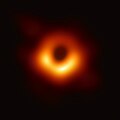Kugelblitz (astrophysics)
This article needs additional citations for verification. (July 2022) |
A kugelblitz (German: [ˈkuːɡl̩ˌblɪt͡s] ) is a theoretical astrophysical object predicted by general relativity. It is a concentration of heat, light or radiation so intense that its energy forms an event horizon and becomes self-trapped. In other words, if enough radiation is aimed into a region of space, the concentration of energy can warp spacetime so much that it creates a black hole. This would be a black hole whose original mass–energy was in the form of radiant energy rather than matter;[1] however, there is currently no uniformly accepted method of distinguishing black holes by origin.
John Archibald Wheeler's 1955 Physical Review paper entitled "Geons" refers to the kugelblitz phenomenon and explores the idea of creating such particles (or toy models of particles) from spacetime curvature.[2]
A study published in Physical Review Letters in 2024 argues that the formation of a kugelblitz is impossible due to dissipative quantum effects like vacuum polarization, which prevent sufficient energy buildup to create an event horizon.[3] The study concludes that such a phenomenon cannot occur in any realistic scenario within our universe.
The kugelblitz phenomenon has been considered a possible basis for interstellar engines (drives) for future black hole starships.[4][5][non-primary source needed]
In fiction
[edit]- A kugelblitz is a major plot point in the third season of the American superhero television series The Umbrella Academy.
- A kugelblitz is the home of a major faction in Frederik Pohl's "Gateway" novels.
See also
[edit]References
[edit]- ^ Senovilla, José M M (2015-01-08). "Black hole formation by incoming electromagnetic radiation". Classical and Quantum Gravity. 32 (1): 017001. arXiv:1408.2778. Bibcode:2015CQGra..32a7001S. doi:10.1088/0264-9381/32/1/017001. ISSN 0264-9381.
- ^ Wheeler, John Archibald (15 January 1955). "Geons". Physical Review. 97 (2): 511–536. Bibcode:1955PhRv...97..511W. doi:10.1103/PhysRev.97.511. ISSN 0031-899X.
- ^ Álvarez-Domínguez, Álvaro; Garay, Luis J.; Martín-Martínez, Eduardo; Polo-Gómez, José (2024-07-26). "No Black Holes from Light". Physical Review Letters. 133 (4): 041401. arXiv:2405.02389. Bibcode:2024PhRvL.133d1401A. doi:10.1103/PhysRevLett.133.041401. ISSN 0031-9007. PMID 39121419.
- ^ 5 REAL Possibilities for Interstellar Travel on YouTube
- ^ Lee, J. S. (December 2013). "The Effect of Hawking Radation on Fermion Re-Inflation of a Schwartszchild Kugelblitz". Journal of the British Interplanetary Society. 66: 364–376. Bibcode:2013JBIS...66..364L. ISSN 0007-084X.
